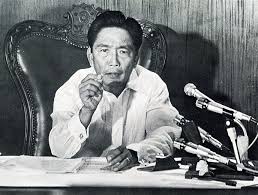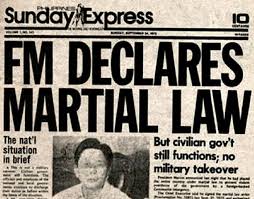OP ED: EDITORIAL- Epic fail – Philippine Daily Inquirer
Ferdinand Marcos used the communist insurgency, then only a few years old, as his main excuse to declare martial law, 46 years ago this weekend. In 1972, the strength of the New People’s Army was estimated at 1,028 rebels; by the time he was People-Powered out of Malacañang Palace in 1986, the NPA had grown to over 22,500 armed regulars. By Marcos’ own standard, then, martial law was—as kids say these days—an epic fail.

Marcos used the martial law regime—a nation-building enterprise he called the New Society, justified by a legal framework he created called constitutional authoritarianism—to advance his original campaign vision, of making the country “great again.” When he came to power, the country’s foreign debt was about $1 billion; when he was ousted, the total had swollen to some $25 billion—a terrible burden on every citizen, which we continue to pay for until today. Under his watch, in 1983 and 1984, the economy had its worst years since the end of World War II. By Marcos’ own standard of “greatness,” then, the Marcos years were an epic fail.
.
– SPACE RESERVE FOR YOUR ADVERTISEMENT –
.
He used the martial law regime to launch what he called a revolution from the center, and pledged to fight the oligarchy that he said controlled the country. But of the 80 or so families that formed the economic elite during the martial law years, many were new oligarchs, the infamous cronies, who rose to power and prominence because of their direct connection to either Marcos or his extravagant wife, Imelda. By Marcos’ own standard of fighting the oligarchy, then, the martial law regime was also an epic fail.
He also used peace and order as another justification for imposing, then extending, then disguising, military rule. He promised to create a culture of discipline and form a government in strict adherence to the rule of law. But with a Supreme Court under his almost total control and lawmaking powers of his own under the new Constitution, he instead built the most repressive regime since the Japanese Occupation. He and his regime were responsible for at least 3,257 recorded killings, some 35,000 documented cases of torture, and about 70,000 incarcerations. By Marcos’ own standard of peace and order, then, martial law was an epic fail.
Martial law succeeded only in one thing: in centralizing control, power and money in the hands of the Marcoses and their cronies. As much as $8 billion of the new foreign debt incurred went straight to them—the worst case of corruption in Philippine history. Even today, even after over P170 billion in ill-gotten wealth from the Marcoses and their cronies have already been recovered by the Presidential Commission on Good Government, his wife and his children continue to contest various attempts around the world to reclaim more hidden wealth.
To all of these incontrovertible facts, his eldest daughter, Imee, who is running for a Senate seat in next year’s elections, and his only son, Bongbong, who is disputing his loss in the 2016 vice presidential election, only have one thing to say to the Filipino people: Move on.
The different protests scheduled today across the country are an appeal from the depths, directed at the Duterte administration, to stop its own Marcosian tactics. From a longstanding sympathizer of the communist insurgency, President Duterte has changed into a strident critic, ready to red-tag any sign of opposition. From the initial signs of optimism two years ago, the administration has turned into the bearer, and the brunt, of bad news: galloping inflation, a weakening peso, indifferent or outright hostile investors. From the first flourish of antioligarchic sentiments, the Duterte era is now transformed into an enabler of a new economic elite.
And despite all the talk about fighting the war on drugs and the war on corruption, even the President confesses that corruption in the government remains pervasive and that the illegal drug trade continues to thrive. But already thousands of people, many of them demonstrably innocent, have been killed.
Supporters of the President, however, continue to spew nonsense about creating a revolutionary government, or pushing through a federalist charter that will concentrate power in his hands. They do not understand history’s lessons: Even though Marcos was able to use martial rule to concentrate power, for a time, he ultimately could not stop the people from wresting it back. That is the one message from today’s many protests.
 All photographs, news, editorials, opinions, information, data, others have been taken from the Internet ..aseanews.net | aseanews@hotmail.com |.For comments, Email to :D’Equalizer | daequalizer@live.com.ph | Contributo
All photographs, news, editorials, opinions, information, data, others have been taken from the Internet ..aseanews.net | aseanews@hotmail.com |.For comments, Email to :D’Equalizer | daequalizer@live.com.ph | Contributo









